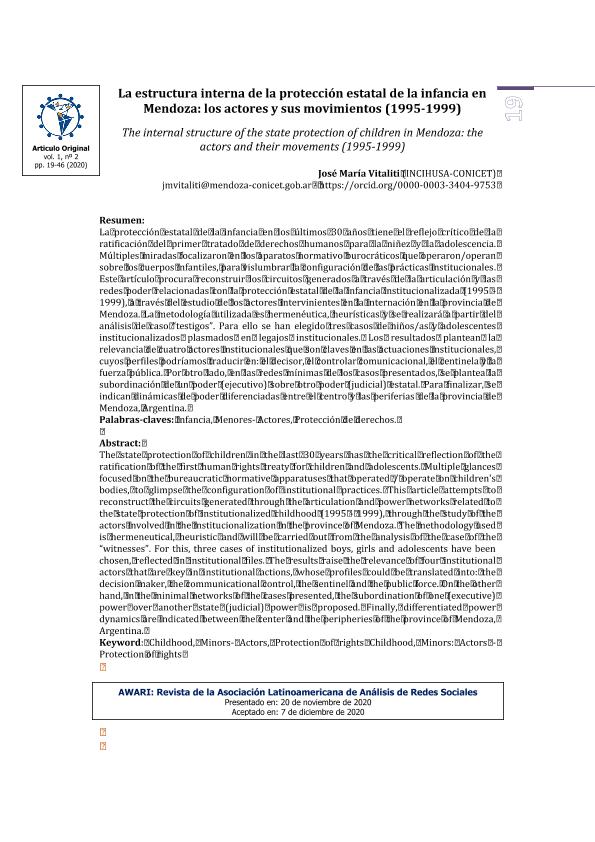Artículo
La protección estatal de la infancia en los últimos 30 años tiene el reflejo crítico de la ratificación del primer tratado de derechos humanos para la niñez y la adolescencia. Múltiples miradas focalizaron en los aparatos normativo burocráticos que operaron/operan sobre los cuerpos infantiles, para vislumbrar la configuración de las prácticas institucionales. Este artículo procura reconstruir los circuitos generados a través de la articulación y las redes poder relacionadas con la protección estatal de la infancia institucionalizada (1995 - 1999), a través del estudio de los actores intervinientes en la internación en la provincia de Mendoza. La metodología utilizada es hermenéutica, heurísticas y se realizará a partir del análisis de casos testigos. Para ello se han elegido tres casos de niños/as y adolescentes institucionalizados plasmados en legajos institucionales. Los resultados plantean la relevancia de cuatro actores institucionales que son claves en las actuaciones institucionales, cuyos perfiles podríamos traducir en: el decisor, el controlar comunicacional, el centinela y la fuerza pública. Por otro lado, en las redes mínimas de los casos presentados, se plantea la subordinación de un poder (ejecutivo) sobre otro poder (judicial) estatal. Para finalizar, se indican dinámicas de poder diferenciadas entre el centro y las periferias de la provincia de Mendoza, Argentina. The state protection of children in the last 30 years has the critical reflection of the ratification of the first human rights treaty for children and adolescents. Multiple glances focused on the bureaucratic normative apparatuses that operated / operate on children's bodies, to glimpse the configuration of institutional practices. This article attempts to reconstruct the circuits generated through the articulation and power networks related to the state protection of institutionalized childhood (1995 - 1999), through the study of the actors involved in the institucionalization in the province of Mendoza. The methodology used is hermeneutical, heuristic and will be carried out from the analysis of the case of the “witnesses”. For this, three cases of institutionalized boys, girls and adolescents have been chosen, reflected in institutional files. The results raise the relevance of four institutional actors that are key in institutional actions, whose profiles could be translated into: the decision maker, the communicational control, the sentinel and the public force. On the other hand, in the minimal networks of the cases presented, the subordination of one (executive) power over another state (judicial) power is proposed. Finally, differentiated power dynamics are indicated between the center and the peripheries of the province of Mendoza, Argentina.
La estructura interna de la protección estatal de la infancia en Mendoza: los actores y sus movimientos (1995-1999)
Título:
The internal structure of the state protection of children in Mendoza: the actors and their movements (1995-1999)
Fecha de publicación:
12/2020
Editorial:
Universidade Federal de Santa Catarina
Revista:
Awari
ISSN:
2675-522X
Idioma:
Español
Tipo de recurso:
Artículo publicado
Clasificación temática:
Resumen
Palabras clave:
Infancia
,
Menores
,
Actores
,
Protección de derechos
Archivos asociados
Licencia
Identificadores
Colecciones
Articulos(INCIHUSA)
Articulos de INST. DE CS. HUMANAS, SOC. Y AMBIENTALES
Articulos de INST. DE CS. HUMANAS, SOC. Y AMBIENTALES
Citación
Vitaliti, Jose Maria; La estructura interna de la protección estatal de la infancia en Mendoza: los actores y sus movimientos (1995-1999); Universidade Federal de Santa Catarina; Awari; 2; 12-2020; 19-46
Compartir




